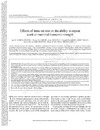Please use this identifier to cite or link to this item:
https://accedacris.ulpgc.es/jspui/handle/10553/52537
| Title: | Effects of intra-set rest on the ability to repeat work at maximal isometric strength | Authors: | García Manso, Juan Manuel Valverde, Teresa Arrones, Luis Navarro Valdivielso, Manuel E. Martin Dantas, Estelio H. Da Silva-Grigoletto, Marzo E. |
UNESCO Clasification: | 241106 Fisiología del ejercicio | Keywords: | Exercise Muscle fatigue Muscle strength |
Issue Date: | 2016 | Publisher: | 0022-4707 | Journal: | Journal of Sports Medicine and Physical Fitness | Abstract: | BACKGROUND: The aim of this paper was to analyze how the rest between interval repetitions in intra-set training (at maximal isometric loads) could affect the ability to repeat maximal contractions in subjects with different levels of performance and different experience in strength development work. METHODS: Twenty subjects were divided randomly into two different groups depending on their sport characteristics: ten subjects were trained in strength development work (Group Strenght - 23.1±4.6 years; 172.0±5.3 cm; 79.9±12.1 kg; 2175.6±490.8 N; 46.9±4.9 mL/kg.min), and ten subjects were trained in endurance work (Group Endurance-21.3±4.5 years; 172.4±4.1 cm; 60.0±4.6 kg; 815.5±206.5 N; 67.4±4.9 mL/kg.min). To assess the ability to repeat maximal efforts, 20 repetitions of 5 seconds were performed in a half-squat position, with 1 minute of rest between repetitions. RESULTS: For both groups, four different phases were observed in the Interval Maximal Force test during the 20-repetition assessment: potentiation, maintenance, moderate loss, and significant loss. For the GE, the loss in maximum strength capacity began in the fourth repetition (GS4th: 3.4%, ns, Effect Size: 0.09 vs. GE3th: 1.6%; ns; ES: 0.06) and reached a statistically significant value in the twelfth repetition (GS12th: 12.7%, P=0.03, ES: 0.35 vs. GE7th: 12.5%; P=0.01; ES: 0.49). The number of repetitions at which the strength began to decrease depended on the subject's sport characteristic and performance level. CONCLUSIONS: This study shows how an appropriate intra-set rest inclusion can significantly increase the work performed in every set without changing the muscle contraction characteristics, thus delaying muscle fatigue and maintaining the desired training objective. | URI: | https://accedacris.ulpgc.es/handle/10553/52537 | ISSN: | 0022-4707 | Source: | Journal of Sports Medicine and Physical Fitness [ISSN 0022-4707], v. 56 (3), p. 214-222 |
| Appears in Collections: | Artículos |
SCOPUSTM
Citations
4
checked on Jun 8, 2025
WEB OF SCIENCETM
Citations
4
checked on Feb 25, 2024
Page view(s)
229
checked on Sep 22, 2024
Download(s)
138
checked on Sep 22, 2024
Google ScholarTM
Check
Share
Export metadata
Items in accedaCRIS are protected by copyright, with all rights reserved, unless otherwise indicated.
